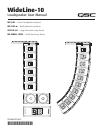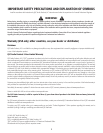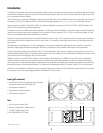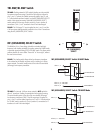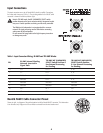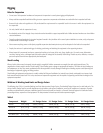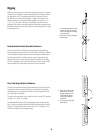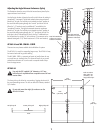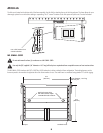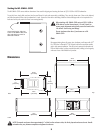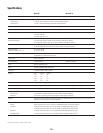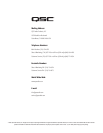
5
6
Rigging
WideLine-10 enclosures use a three-point suspension system. The system
consists of front, left/right, captive articulated joints and a single rear link
bar. Articulation is in 2° increments using the first location on the link
bar. With the use of the second location, 1° degree increments can be
obtained starting at 3°. The total available angular increments are: 0, 2,
3, 4, 5, 6, 7, 8, 9, and 10°. All pieces and locking pins remain with the
enclosures. No ancillary items are needed to suspend the enclosures from
the WideLine-10 array frame. All ball-lock pins are equipped with a lanyard
to help prevent loss.
Front Articulated Joint (Knuckle) Hardware
Expose the end of the articulated joint by locating the joint’s retaining
screw protruding from the front of the receiver tube and sliding it upward.
The front captive joint will slide upward from the enclosure’s receiver tube.
The exposed end of the articulated joint can now be inserted into the
adjacent enclosure’s receiver tube and locked into position by a locking
pin. This is repeated for each side of the enclosure. Then the rear link bar
can be rotated into position and pinned at the chosen increment.
Rear Link (Angle Adjust) Hardware
The rear link is stored with the link folded between the sides of the block.
To expose the link, remove the ball-lock pin and rotate the link into the
desired position. Once positioned, the link is secured using the ball-lock
pin of the adjacent enclosure.
The rear link is marked with a thin, white line at the “normal” (0°) position
and with a “+3” at the +3° position.
The additional ball-lock pin hole (located approximately midway on the
link) is used for storing the link when folded into the enclosure’s block for
storage. The link may be pinned in place at the 0° or 8° location on the
block when rotated into the storage position.
1
2
Front Articulated Joint—Slide 1.
the joint out of the receiver
tube by sliding the retaining
screw upward.
Then lock in place using the 2.
ball-lock pin.
Rear Link—Remove the 1.
ball-lock pin from the
storage position, then
rotate the link down-
ward to the adjacent
enclosure.
Lock in place using the 2.
ball-lock pin.
1
2



